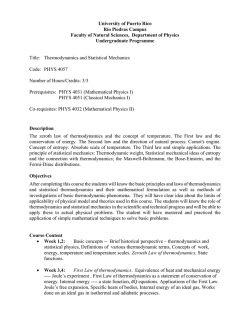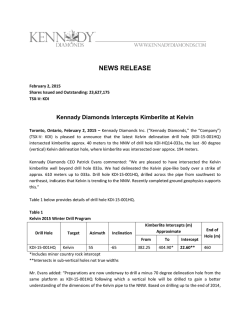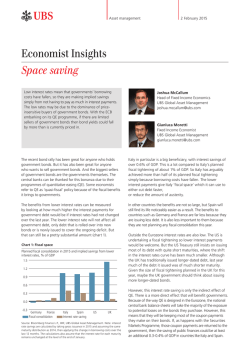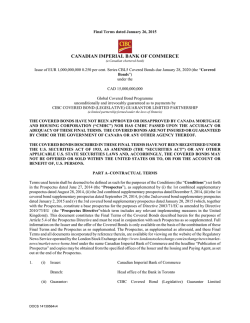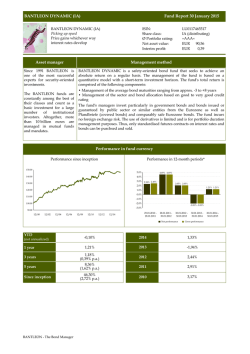
Basics_of_Thermodynamics - IITK
Basics of Thermodynamics Some of the material covered here is also covered in the chapter/topic on: Equilibrium MATERIALS SCIENCE Part of & A Learner’s Guide ENGINEERING AN INTRODUCTORY E-BOOK Anandh Subramaniam & Kantesh Balani Materials Science and Engineering (MSE) Indian Institute of Technology, Kanpur- 208016 Email: [email protected], URL: home.iitk.ac.in/~anandh http://home.iitk.ac.in/~anandh/E-book.htm Reading Four Laws that Drive the Universe Peter Atkins* Oxford University Press, Oxford, 2007 Physical Chemistry Ira N Levine Tata McGraw Hill Education Pvt. Ltd., New York (2002). *It is impossible for me to write better than Atkins- his lucid (& humorous) writing style is truly impressive- paraphrasing may lead to loss of the beauty of his statements- hence, some parts are quoted directly from his works. Thermodynamics versus Kinetics Thermodynamics deals with stability of systems. It tells us ‘what should happen?’. ‘Will it actually happen(?)’ is not the domain of thermodynamics and falls under the realm of kinetics. At –5C at 1 atm pressure, ice is more stable then water. Suppose we cool water to –5C. “Will this water freeze?” (& “how long will it take for it to freeze?”) is (are) not question(s) addressed by thermodynamics. Systems can remain in metastable state for a ‘long-time’. Window pane glass is metastable– but it may take geological time scales for it to crystallize! At room temperature and atmospheric pressure, graphite is more stable then diamond– but we may not lose the glitter of diamond practically forever! * The term metastable is defined in the chapter on equilibrium. Thermodynamics (TD): perhaps the most basic science One branch of knowledge that all engineers and scientists must have a grasp of (to some extent or the other!) is thermodynamics. In some sense thermodynamics is perhaps the ‘most abstract subject’ and a student can often find it very confusing if not ‘motivated’ strongly enough. Thermodynamics can be considered as a ‘system level’ science- i.e. it deals with descriptions of the whole system and not with interactions (say) at individual particles level. I.e. it deals with quantities (like T,P) averaged over a large collection of entities (like molecules, atoms)*. This implies that questions like: “What is the temperature or entropy of an atom?”; do not make sense in the context of thermodynamics (at lease in the usual way!). TD puts before us some fundamental laws which are universal** in nature (and hence applicable to fields across disciplines). * Thermodynamics deals with spatio-temporally averaged quantities. ** they apply to the universe a whole as well! The language of TD To understand the laws of thermodynamics and how they work, first we need to get the terminology right. Some of the terms may look familiar (as they are used in everyday language as well)- but their meanings are more ‘technical’ and ‘precise’, when used in TD and hence we should not use them ‘casually’. System is region where we focus our attention (Au block in figure). Surrounding is the rest of the universe (the water bath at constant ‘temperature’). Universe = System + Surrounding More practically, we can consider the ‘Surrounding’ as the immediate neighbourhood of the system (the part of the universe at large, with which the system ‘effectively’ interacts). In this scheme of things we can visualize: a system, the surrounding and the universe at large. In TD we usually we do not worry about the universe at large! Open, closed and isolated systems To a thermodynamic system two ‘things’ may be added/removed: energy (heat, work) matter. An open system is one to which you can add/remove matter (e.g. a open beaker to which we can add water). When you add matter- you also end up adding heat (which is contained in that matter). A system to which you cannot add matter is called closed. Though you cannot add/remove matter to a closed system, you can still add/remove heat (you can cool a closed water bottle in fridge). A system to which neither matter nor heat can be added/removed is called isolated. A closed vacuum ‘thermos’ flask can be considered as isolated. Type of boundary Interactions Open All interactions possible Closed Matter cannot enter or leave Semi-permeable Only certain species can enter or leave Insulated Heat cannot enter or leave Rigid Mechanical work cannot be done* Isolated No interactions are possible** * By or on the system ** Mass, Heat or Work Mass Interactions possible Work Heat Matter is easy to understand and includes atoms, ions, electrons, etc. Energy may be transferred (‘added’) to the system as heat, electromagnetic radiation etc. In TD the two modes of transfer of energy to the system considered are Heat and Work. Heat and work are modes of transfer of energy and not ‘energy’ itself. Once inside the system, the part which came via work and the part which came via heat, cannot be distinguished. More sooner on this! Matter when added to a system brings along with it some energy. The ‘energy density’ (energy per unit mass or energy per unit volume) in the incoming matter may be higher or lower than the matter already present in the system. Processes in TD We will deal with some of them in detail later on Here is a brief listing of a few kinds of processes, which we will encounter in TD: Isothermal process → the process takes place at constant temperature (e.g. freezing of water to ice at –10C) Isobaric → constant pressure (e.g. heating of water in open air→ under atmospheric pressure) Isochoric → constant volume (e.g. heating of gas in a sealed metal container) Reversible process → the system is close to equilibrium at all times (and infinitesimal alteration of the conditions can restore the universe (system + surrounding) to the original state. Cyclic process → the final and initial state are the same. However, q and w need not be zero. Adiabatic process → dq is zero during the process (no heat is added/removed to/from the system) A combination of the above are also possible: e.g. ‘reversible adiabatic process’. Temperature Though we all have a feel for temperature (‘like when we are feeling hot’); in the context of TD temperature is technical term with ‘deep meaning’. As we know (from a commons sense perspective) that temperature is a measure of the ‘intensity of heat’. ‘Heat flows’ (energy is transferred as heat) from a body at higher temperature to one at lower temperature. (Like pressure is a measure of the intensity of ‘force applied by matter’→ matter (for now a fluid) flows from region of higher pressure to lower pressure). That implies (to reiterate the obvious!) if I connect two bodies (A)-one weighing 100kg at 10C and the other (B) weighing 1 kg at 500C, then the ‘heat will flow’ from the hotter body to the colder body (i.e. the weight or volume of the body does not matter). But, temperature comes in two important ‘technical’ contexts in TD: 1 it is a measure of the average kinetic energy (or velocity) of the constituent entities (say molecules) 2 it is the parameter which determines the distribution of species (say molecules) across various energy states available. A 10C Heat flow direction B 500C Temperature as a parameter determining the distribution of species across energy levels Let us consider various energy levels available for molecules in a system to be promoted to. At low temperatures the lower energy levels are expected to be populated more, as compared to higher energy levels. As we heat the system, more and more molecules will be promoted to higher energy levels. The distribution of molecules across these energy levels is given by: Pressure Pressure* is force per unit area (usually exerted by a fluid on a wall**). It is the momentum transferred (say on a flat wall by molecules of a gas) per unit area, per unit time. (In the case of gas molecules it is the average momentum transferred per unit area per unit time on to the flat wall). P = momentum transferred/area/time. Wall of a container Pressure is related to momentum, while temperature is related to kinetic energy. ‘Crude schematic’ of particles impinging on a wall. * ‘Normal’ pressure is also referred to as hydrostatic pressure. ** Other agents causing pressure could be radiation, macroscopic objects impinging on a wall, etc. Heat and Work Work (W) in mechanics is displacement (d) against a resisting force (F). W = F d Work has units of energy (Joule, J). Work can be expansion work (PV), electrical work, magnetic work etc. (many sets of stimuli and their responses). Heat as used in TD is a tricky term (yes, it is a very technical term as used in TD). The transfer of energy as a result of a temperature difference is called heat. “In TD heat is NOT an entity or even a form of energy; heat is a mode of transfer of energy” [1]. “Heat is the transfer of energy by virtue of a temperature difference” [1]. “Heat is the name of a process, not the name of an entity” [1]. “Bodies contain internal energy (U) and not heat” [2]. The ‘flow’ of energy down a temperature gradient can be treated mathematically by considering heat as a mass-less fluid [1] → this does not make heat a fluid! Expansion work To give an example (inspired by [1]): assume that you start a rumour that there is ‘lot of’ gold under the class room floor. This rumour ‘may’ spread when persons talk to each other. The ‘spread of rumor’ with time may be treated mathematically by equations, which have a form similar to the diffusion equations (or heat transfer equations). This does not make ‘rumour’ a fluid! [1] Four Laws that Drive the Universe, Peter Atkins, Oxford University Press, Oxford, 2007. [2] Physical Chemistry, Ira N Levine, Tata McGraw Hill Education Pvt. Ltd., New York (2002). Work is coordinated flow of matter. Lowering of a weight can do work Motion of piston can do work Flow of electrons in conductor can do work. Heat involves random motion of matter (or the constituent entities of matter). Like gas molecules in a gas cylinder Water molecules in a cup of water Atoms vibrating in a block of Cu. Energy may enter the system as heat or work. Once inside the system: it does not matter how the energy entered the system* (i.e. work and heat are terms associated with the surrounding and once inside the system there is no ‘memory’ of how the input was received and the energy is stored as potential energy (PE) and kinetic energy (KE). This energy can be withdrawn as work or heat from the system. * As Aktins put it: “money may enter a back as cheque or cash but once inside the bank there is no difference”. Reversible process ‘Reversible’ is a technical term (like many others) in the context of TD. A reversible process is one where an infinitesimal change in the conditions of the surroundings leads to a ‘reversal’ of the process. (The system is very close to equilibrium and infinitesimal changes can restore the system and surroundings to the original state). If a block of material (at T) is in contact with surrounding at (TT), then ‘heat will flow’ into the surrounding. Now if the temperature of the surrounding is increased to (T+T), then the direction of heat flow will be reversed. If a block of material (at 40C) is contact with surrounding at 80C then the ‘heat transfer’ with takes place is not reversible. Though the above example uses temperature differences to illustrate the point, the situation with other stimuli like pressure (differences) is also identical. Consider a piston with gas in it a pressure ‘P’. If the external pressure is (P+P), then the gas (in the piston) will be compressed (slightly). The reverse process will occur if the external (surrounding pressure is slightly lower). Maximum work will be done if the compression (or expansion) is carried out in a reversible manner. Reversible process Heat flow direction Heat flow direction T TT NOT a Reversible process Heat flow direction T T+T 40C 80C How to visualize a ‘reversible’ equivalent to a ‘irreversible’ processes? Let us keep one example in mind as to how we can (sometimes) construct a ‘reversible’ equivalent to a ‘irreversible’ processes. Let us consider the example of the freezing of ‘undercooled water’* at –5C (at 1 atm pressure). This freezing of undercooled water is irreversible (P1 below). We can visualize this process as taking place in three reversible steps hence making the entire process reversible (P2 below). P1 Water at –5C Irreversible Water at –0C P2 Heat Water at –5C Ice at –5C Ice at –0C Reversible Cool Ice at –5C * ‘Undercooled’ implies that the water is held in the liquid state below the bulk freezing point! How is this possible?→ read chapter on phase transformations Reversible P-V work on a closed system In a closed system (piston in the example figure below), if infinitesimal pressure increase causes the volume to decrease by V, then the work done on the system is: The system is close to equilibrium during the whole process thus making the process reversible. dwreversible PdV As V is negative, while the work done is positive (work done on the system is positive, work done by the system is negative). If the piston moves outward under influence of P (i.e. ‘P’ and V are in opposite directions, then work done is negative. 1 P 2 ‘Ultimately’, all forms of energy will be converted to heat!! One nice example given by Atkins: consider a current through a heating wire of a resistor. There is a net flow of electrons down the wire (in the direction of the potential gradient) i.e. work is being done. Now the electron collisions with various scattering centres leading to heating of the wire i.e. work has been converted into heat. State functions in TD A property which depends only on the current state of the system (as defined by T, P, V etc.) is called a state function. This does not depend on the path used to reach a particular state. Analogy: one is climbing a hill- the potential energy of the person is measured by the height of his CG from ‘say’ the ground level. If the person is at a height of ‘h’ (at point P), then his potential energy will be mgh, irrespective of the path used by the person to reach the height (paths C1 & C2 will give the same increase in potential energy of mgh- in figure below). In TD this state function is the internal energy (U or E). (Every state of the system can be ascribed to a unique U). Hence, the work needed to move a system from a state of lower internal energy (=UL) to a state of higher internal energy (UH) is (UH) (UL). W = (UH) (UL) The internal energy of an isolated system (which exchages neither heat nor mass) is constant this is one formulation of the first law of TD. A process for which the final and initial states are same is called a cyclic process. For a cyclic process change in a state function is zero. E.g. U(cyclic process) = 0. Spontaneous and Driven processes A spontaneous process is one which occurs ‘naturally’, ‘down-hill’ in energy*. I.e. the process does not require input of work in any form to take place. Melting of ice at 50C is a spontaneous process. A driven process is one which wherein an external agent takes the system uphill in energy (usually by doing work on the system). Freezing of water at 50C is a driven process (you need a refrigerator, wherein electric current does work on the system). Later on we will note that the entropy of the universe will increase during a spontaneous change. (I.e. entropy can be used as a single parameter for characterizing spontaneity). Spontaneous process (Click to see) * The kind of ‘energy’ we are talking about depends on the conditions. As in the topic on Equilibrium, at constant temperature and pressure the relevant TD energy is Gibbs free energy. Heat Capacity Heat capacity is the amount of heat (measured in Joules or Calories) needed to raise an unit amount of substance (measured in grams or moles) by an unit in temperature (measured in C or K). This ‘heating’ (addition of energy) can be carried out at constant volume or constant pressure. At constant pressure, some of the heat supplied goes into doing work of expansion and less is available with the system (to raise it temperature). Heat capacity at constant Volume (CV): E C V It is the slope of the plot of internal energy with temperature. T V Heat capacity at constant Pressure (CP): H It is the slope of the plot of enthalpy with temperature. CP T P Units: Joules/Kelvin/mole, J/K/mole, J/C/mole, J/C/g. Heat capacity is an extensive property (depends on ‘amount of matter’) If a substance has higher heat capacity, then more heat has to be added to raise its temperature. Water with a high heat capacity (of *****) heats up slowly as compared to air (with a heat capacity, CP = 29.07J/K/mole) this implies that oceans will heat up slowly as compared to the atomosphere. As T0K, the heat capacity tends to zero. I.e near 0 Kelvin very little heat is required to raise the temperature of a sample. (This automatically implies that very little heat has to added to raise the temperature of a material close to 0K. This is of course bad news for cooling to very low temperatures small leakages of heat will lead to drastic increase in temperature). The Laws of Thermodynamics The First Law The internal energy of an isolated system is constant. A closed system may exchange energy as heat or work. Let us consider a close system at rest without external fields. There exists a state function U such that for any process in a closed system: U = q + w [1] q → heat flow in to the system w → work done on the system (work done by the system is negative of above- this is just ‘one’ sign convention) q & w are not state functions → i.e. they depend on the path of a process. U is the internal energy. Being a state function for a process U depends only of the final and initial state of the system. U = Ufinal – Uinitial. In contrast to U, q & w are NOT state functions (i.e. depend on the path followed). For an infinitesimal process eq. [1] can be written as: dU = dq + dw The change in U of the surrounding will be opposite in sign, such that: Usystem + Usurrounding = 0 Actually, it should be E above and not U {however, in many cases K and V are zero (e.g. a system at rest considered above) and the above is valid- as discussed elsewhere}. It is to be noted that in ‘w’ work done by one part of the system on another part is not included. The Second Law The second law comes in many equivalent forms It is impossible to build a cyclic machine that converts heat into work with 100% efficiency Kelvin’s statement of the second law. Another way of viewing the same: it is impossible to construct a cyclic machine* that completely (with 100% efficiency) converts heat, which is energy of random molecular motion, to mechanical work, which is ordered motion. The unavailable work is due to the role of Entropy in the process. Heat reservoir Heat q Cyclic engine Not possible 100% Heat reservoir Heat q Work (w) Cyclic engine Heat q’ Cold Reservoir Work (w) * These ‘engines’ which use heat and try to produce work are called heat engines. Kelvin’s statement of the second law Another statement of the second law → the Clausius statement Heat does not ‘flow*’ from a colder body to a hotter body, without an concomitant change outside of the two bodies Clausius’s statement of the second law.(a) This automatically implies that the spontaneous direction of the ‘flow of heat*’ is from a hotter body to a colder body.(b) The Kelvin’s and Clausius’s statements of the second law are equivalent. I.e. if we violate Kelvin’s statement, then we will automatically violate the Clausius’s statement of the second law (and vice-versa). * Used here in the ‘common usage sense’. (b) is obvious, but not (a) → though they represent the same fact. A combined (Kelvin + Clausius) statement of the II Law The entropy of the universe will increase during any spontaneous change. The efficiency of a heat engine The efficiency of a heat engine is the amount of work output divided by the amount of heat input. This efficiency depends only on the ratio of the temperature of the sink to the temperature of the source. The maximum efficiency achievable is given by the formula below. This is surprising as: there is no mention of the medium of the system (or its properties), the formula has only temperatures and the temperature of the sink seems to play a major role (as the presence of the sink is usually not intentional or obvious→ in a steam engine sink is the air around the engine and source is the hot steam). Important message Sink (characterized by its temperature) is as important as the source. To increase the maximum possible efficiency of a heat engine, either the temperature of the source has to be increased on the temperature of the sink has to be decreased. heat engine woutput qinput Tsink T source max heat engine 1 Clausius statement of the second law Heat cannot spontaneously flow from a cold (low temperature) body to a hot body. To make heat flow from a cold body to a hot body, there must be accompanying change elsewhere (work has to be done to achieve this). The Third Law For substances in internal equilibrium, undergoing an isothermal process, the entropy change goes to zero as T (in K) goes to zero. lim S 0 T 0 The law is valid for pure substances and mixtures. Close to Zero Kelvin, the molecular motions have to be treated using quantum mechanics → still it is found that quantum ideal gases obey the third law. Ideal and Perfect Gases To understand the basics often we rely on simple ‘test-bed’ systems. In TD one such system is the ideal gas. In an ideal gas the molecules do not interact with each other (Noble gases come close to this at normal temperatures). An ideal gas obeys the equation of state: PV nRT As the molecules of a ideal gas do not interact with each other, the internal energy of the system is expected to be ‘NOT dependent’ on the volume of the system. I.e.: U 0 V T A gas which obeys both the above equations is called a perfect gas. Internal energy (a state function) is normally a function of T & V: U = U(T,V). For a perfect gas: U = U(T) only. Humorous look at the three laws The first law says: “you cannot win”. The second law says: “you can at best break even- that too at zero Kelvin”. Third law says: “zero Kelvin is unattainable”. What happens when we mix two elements (say Ag and Au→ two crystals)? When we mix two (or for that matter more) elements (A & B), the stable phase will be that with the lowest G. There are three options here (as we have seen in Chapter 4a): 1 Phase separation → A & B do not want to talk to each other 2 Formation of solid solution → A & B do not care about their environment 3 Compound formation → A & B prefer each other’s environment as compared to their own environment In a compound the each one of the components are fixed to their sub-lattices and hence the configurational entropy of the compound is zero. This is true in the case of a complete phase separation as well (i.e. the configurational entropy is zero). The solid solution is also called a disordered solid solution, in which case each component is randomly occupies a lattice point without any preference. In practice, there might be some tendency for ‘ordering’ (i.e. compound formation) or ‘clustering’ (phase separation) and in that case the ‘random configuration’ assumption will be violated. The Gibbs free energy change on mixing (for now we visualize mixing– soon we will see if they actually mix!) is: Gmix = Gmixed state – Gunmixed state = Hmix – T Smix. H = H –H . mix mixed state unmixed Hence, if we know two numbers (Hmix, Smix) our job is done! The game-plan is to find these numbers (especially, Hmix). Various models are used for this purpose and that can be quite confusing! Each one of these models come with their own baggage of assumptions (& hence approximations). The simplest model of mixing is the formation of the ideal solution. In an ideal solution AB bonds are energetically no different from the A-A or B-B bonds. This implies that (Hmix)ideal solution = 0. If (Hmix)ideal solution 0, which usually happens in practice (i.e. usually the mixing process is endothermic or exothermic), then we need a more ‘realistic’ computation of Hmix. One of the popular models is the regular solution model (which is based on the quasi-chemical approach). In real alloys the following factors come into the picture, which can lead to substantial deviation from the some of the models considered: (i) ordering (if Hmix is very negative), (ii) clustering (leading to deviation from the random configuration model, (iii) strain in the lattice due to size difference between the atoms (the quasi-chemical model will underestimate the change in internal energy on mixing), (iv) substantial size difference leading to the formation of a interstitial solid solution. Ideal solution Gmix ideal solution T .Smix Smix R( X A ln X A X B ln X B ) Gmix ideal solution RT ( X A ln X A X B ln X B ) Gmix → 0 A Increasing T XB → B Regular solution model (quasi-chemical approach) No change in volume before and after mixing The regular solution model makes the following assumptions: A + B = AB (i) the enthalpy of mixing is only due to nearest neighbour atoms, (ii) volume of A and B (per mole) is the same and there is no volume change due to the mixing process (interatomic distances and bond energies are independent of the composition), (iii) point (ii) above also implies that there is no strain in the lattice. If no. of A-A bonds (per mole) is NAA, the no. of B-B bonds is NBB and the no. of A-B bonds is NAB and the corresponding bond energies (per bond) are given by EAA, EBB & EAB the internal energy of the solution is given by (Esolution): Esolution N AA EAA N BB EBB N AB EAB The change in internal energy on mixing (noting that since there is no change in volume, E = H): H mix N AB E Where E E 1 ( E E ) AB 2 AA BB Three scenarios are possible regarding the sign of E E<0 → Hmix negative Sign of E AB bonds are preferred over AA or BB bonds E= 0 → Hmix is zero Ideal solution (no difference between AA, AB or BB bonds E>0 → Hmix is positive AB bonds less preferred over AA or BB bonds Let us consider the scenarios a little further If E= 0 → Hmix is zero Ideal solution (no difference between AA, AB or BB bonds For an ideal solution it can be shown that: N AB z N0 X A X B N0 → Avogadro’s No. z → No. of bonds per atom If E is not too negative or E is not too positive The equation in the case of the ideal solution for NAB can still be used as an approximation N AB z N0 X A X B This implies: H mix z N0 X A X B E X A X B H mix X A X B z N0 E E EAB 12 ( EAA EBB ) Gmix regular solution X A X B RT ( X A ln X A X B ln X B ) H mix T Smix This implies that for regular solutions is the key parameter determining the behaviour of the regular solution ( in turn depends on E, which is ‘some’ measure of the relative values of AA and AB bond energies). The effect of (& T) High T Could be –T or ‘nothing’ Low T Could be H, S or G <0 >0 We will understand these figures in the coming slides Understanding the G- composition curves: General aspects The parameter determines the sign of the Hmix is obviously zero for pure (unmixed) components As mixing leads to an increase in entropy and T is always positive (in K) –TSmix term is always negative The Gmix is determined just by the addition of the Hmix & –TSmix for each composition The Smix term only depends on the composition for a random solid solution <0 Hsolution < Hpure components High T As Hmix & –TSmix are both negative Gmix is always negative. Gmix gets more negative with increasing T due to the –TSmix. Low T The phase diagram of such a system will show complete solubility at high T and phase separation for a range of compositions (in the middle) at low T. Hsolution > Hpure components High T Hmix and –TSmix oppose each other at high ‘enough’ T, –TSmix wins at all compositions and Gmix is always negative At ‘low’ T, Hmix wins over –TSmix for some compositions (in the ‘middle’) and Gmix turns positive for this range of compositions. Low T Except at absolute zero (T), Gmix always decreases on the addition of a small amount of solute (even if Hmix gets ‘very’ positive). >0
© Copyright 2025
